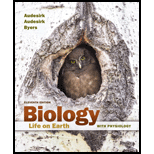
Biology: Life on Earth with Physiology Plus Mastering Biology with Pearson eText -- Access Card Package (11th Edition)
11th Edition
ISBN: 9780133910605
Author: Gerald Audesirk, Teresa Audesirk, Bruce E. Byers
Publisher: PEARSON
expand_more
expand_more
format_list_bulleted
Concept explainers
Question
Chapter 45.5, Problem 2TC
Summary Introduction
To determine:
The advantage of encouraging hummingbirds while discouraging bees.
Introduction:
The floral parts of a flower are the basic determiners of their pollination type. Flowers having small petals and light pollen are usually wind-pollinated. Large, colorful, nectar containing and sweetly scented flowers are often insect-pollinated or bird-pollinated.
Expert Solution & Answer
Want to see the full answer?
Check out a sample textbook solution
Students have asked these similar questions
Why is it important for bees to attract bright colored flowers
Both wind and water pollinated flowers are not very colourful and do not produce nectar. What would be the reason for this?
Which statement about wind-pollinated plants is correct?
Their stamens and stigmas are inside the flower and, compared to insect-pollinated plants, they have large petals
Their stamens and stigmas are outside the flower and, compared to insect-pollinated plants, they have small petals
Their stamens and stigmas are outside the flower and, compared to insect-pollinated plants, they have large petals
Chapter 45 Solutions
Biology: Life on Earth with Physiology Plus Mastering Biology with Pearson eText -- Access Card Package (11th Edition)
Ch. 45.1 - Prob. 1CYLCh. 45.1 - diagram the life cycles of ferns and flowering...Ch. 45.2 - Prob. 1CSCCh. 45.2 - diagram the structure of a complete flower and...Ch. 45.2 - During finals week in the spring semester, a...Ch. 45.2 - Prob. 1TCCh. 45.2 - Prob. 2CYLCh. 45.2 - explain the processes of pollination and double...Ch. 45.3 - explain how the parts of a flower develop into the...Ch. 45.3 - Prob. 1HYEW
Ch. 45.3 - describe the differences between monocot and dicot...Ch. 45.4 - explain why many seeds undergo dormancy before...Ch. 45.4 - Prob. 2CYLCh. 45.5 - The warmth of hot flowers attracts pollinators and...Ch. 45.5 - Prob. 1CYLCh. 45.5 - Prob. 1TCCh. 45.5 - Prob. 2TCCh. 45.6 - Prob. 1CSCCh. 45.6 - Prob. 1CYLCh. 45.6 - Why doesnt mistletoe simply drop its seeds?Ch. 45.6 - describe how fruit structures aid in seed...Ch. 45.6 - Prob. 2TCCh. 45.6 - Heat-producing flowers are rare, and many are...Ch. 45 - Prob. 1ACCh. 45 - Prob. 1FIBCh. 45 - Prob. 1MCCh. 45 - Diagram the general plant life cycle. Which stages...Ch. 45 - Prob. 2ACCh. 45 - In a flowering plant, the male gametophyte is the...Ch. 45 - Prob. 2MCCh. 45 - Prob. 2RQCh. 45 - Prob. 3ACCh. 45 - Prob. 3FIBCh. 45 - Prob. 3MCCh. 45 - Prob. 3RQCh. 45 - Prob. 4FIBCh. 45 - Which of the following is True? a. Moth-pollinated...Ch. 45 - Prob. 4RQCh. 45 - Prob. 5FIBCh. 45 - Prob. 5MCCh. 45 - Prob. 5RQCh. 45 - Describe the characteristics you would expect to...Ch. 45 - Prob. 7RQCh. 45 - Describe three mechanisms whereby seed dormancy is...Ch. 45 - Prob. 9RQCh. 45 - Describe three types of fruits and the mechanisms...
Knowledge Booster
Learn more about
Need a deep-dive on the concept behind this application? Look no further. Learn more about this topic, biology and related others by exploring similar questions and additional content below.Similar questions
- Pollen grains of water pollinated species have a special characteristics for protection from water. What is that?arrow_forwardWhat is the evolutionary advantage for a flowering plant to be pollinated with pollen from a different individual plant (of the same species)?arrow_forwardIn the Kotukutuku plant, Fuchsia excortiata, why do pollinated flowers remain attached to the plant for several days after pollination occurs and nectar is no longer produced Size of flower and pollination Annual versus perennial reproduction Time and expense to grow the pollen tube outweighs the cost of maintaining the flower on the tree Size of flower and number of flowers on inflorescencearrow_forward
- Most wind pollinated flowering plants have incospicuous non-fragrant flowers. How might nature be affected if all flowers were that way?arrow_forwardThe oat coleoptiles of the seedlings above have been modified: either cut or placed in a light-blocking tube. Which ones will stills bend toward a directional light source?arrow_forwardWhat is pollination? The transfer of pollen from stigma to anther The transfer of pollen from stigma to ovary The transfer of pollen from anther to stigmaarrow_forward
- What would happen to a certain type of flower if its natural pollinator were killed by an insecticide?arrow_forwardWhich hormone(s) is/are responsible for the ability of sunflowers to turn their flowers to track the sun throughout the day? Explain how these hormones work.arrow_forwardWhat is Pollination ? germination of pollen grains growth of pollen tube in ovule transfer of pollen from anther to stigma visiting flowers by insectsarrow_forward
- Name one plant each where pollination occurs with the help of : a) Water. b) Batsarrow_forwardHow do the petals of wind-pollinated flowers differ from the petals of most insect-pollinated flowers? How is this difference adapative?arrow_forwardWhat is the difference between self-pollination and cross-pollination? If pollen is transferred from the stamens of a flower to the stigma of the very same flower, is that cross-pollination or self-pollination? If it is transferredfrom the stamen of one flower to the stigma of another flower on the very same plant? If it is transferred from the stamen of one flower to the stigma of another flower on a different plant, but a plant that is a clone of the first one? Animals do not have pollen, of course, but why is it that most animals never have to worry about the equivalent problem of self-fertilization? Why cannot most animals fertilize themselves?arrow_forward
arrow_back_ios
SEE MORE QUESTIONS
arrow_forward_ios
Recommended textbooks for you

Plant Reproduction in Angiosperms; Author: Amoeba Sisters;https://www.youtube.com/watch?v=HLYPm2idSTE;License: Standard YouTube License, CC-BY